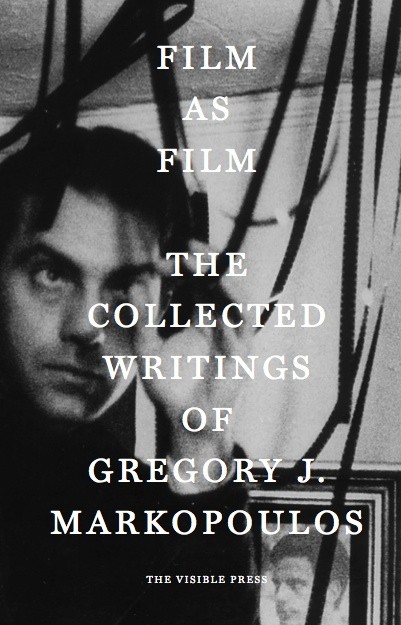Currently celebrated with a major retrosepctive at the Film Museum, important independent Filmmaker Gregory J. Markopoulos (1928-1992) was also a prolific writer of poetry, prose and letters. His texts were frequently published in Film Culture, Film Comment and other journals, but the vast majority of Markopoulos’ writings have been unavailable for decades–until the recent publication of Mark Webber’s beautiful anthology “Film as Film: The Collected Writings of Gregory J. Markopoulos”, which combines practically all of Markopoulos’ known texts with a large number of previously unpublished manuscripts discovered during research in the Temenos Archive.
With the kind permission of Markopoulos’ partner, Robert Beavers (now the keeper of his estate), and Mark Webber, both of whom are currently in town to accompany the Film Museum series, this blog presents one of the texts from the book: “Towards a New Narrative Film Form” was written by Gregory J. Markopoulos in 1963 and relates to the new editing concept of ‘thought-images’ that was developed in the making of his film Twice a Man (1963). The essay appears, alongside almost 100 other texts by the filmmaker, in “Film as Film: The Collected Writings of Gregory J. Markopoulos” (The Visible Press, 2014). The book is available for purchase from the Filmmuseum, priced €25, and can be ordered online direct from the publisher.

Towards a New Narrative Film Form
In the beginning of the motion picture, the film frame had great potential. But with the introduction of sound, a part of the frame was relegated to the service of the soundtrack. Aesthetically opposed but artistically united, sound and image failed to achieve that poetic unity in cinema that everyone had envisioned. Word and image conflicted, forcing images to become conventional, and sound retarded, rather than added to, the development of film form.
Few significant forms have been established in motion pictures; form cannot be achieved through the use of filters, changes in colour intensities, special lenses, effects prepared in the laboratory, elaborate costumes, or theatrical devices. The film frame which creates each shot or composition has been neglected; it has been understood only as a photographic necessity.
I propose a new narrative form through the fusion of the classic montage technique with a more abstract system. This system involves the use of short film phrases which evoke thought-images. Each film phrase is composed of certain select frames that are similar to the harmonic units found in musical composition. The film phrases establish ulterior relationships among themselves; in classic montage technique there is a constant reference to the continuing shot; in my abstract system there is a complex of differing frames being repeated.
The chief problem facing the maker of a motion picture with the proposed abstract form is the elimination of the abruptness with which the single frames attack the eye and confuse the viewer. Both the optical and psychological disturbances may be minimized by a method of integrated frame adjacencies intermingling at their common border or frontier. At other times, dissimilarities or degrees of contrast, object displacement, or varieties of movement in the two contiguous frames will help the viewer receive the abrupt transitions with more ease.
Limitless change in rhythm, or the sudden interjection of alliteration, metaphor, symbol, or any discontinuity introduced in the structure of the motion picture, makes possible the arrest of the film spectator’s attention, as the filmmaker gradually convinces the spectator not only to see and to hear, but to participate in what is being created on the screen, on both the narrative and introspective levels. The magnificent landscapes of emotion, with colours brighter than the film viewer has ever been concerned, begin to exist. The transient impact of meetings, handshakes, kisses and the hours apart from these contacts becomes revealed in all its astounding simplicity. A whole new scale of values is exposed, creating a rich potential narrative form in the motion picture.
Gregory J. Markopoulos
7th of February, 1963
New York City
© The Estate of Gregory J. Markopoulos.
Previously published in: Film Comment No. 6 (Fall 1963) (edited version), Film Culture No. 31 (Winter 1963-64), Filmkritik No. 136 (April 1968), Filmcritica No. 169/170 (August-September 1966), Chaos Phaos II (1971)